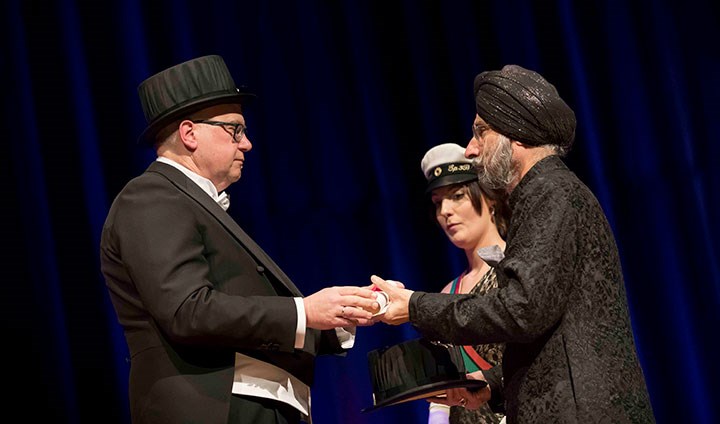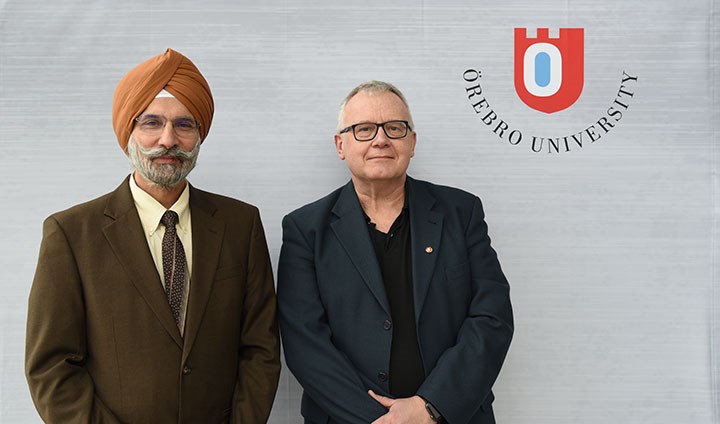Twenty-year collaboration between Örebro and Stanford on pain in newborns

Mats Eriksson hands over the diploma to Kanwaljeet Anand.
“For me, it all started with a girl named Emma and her need for heart surgery,” says Stanford professor Kanwaljeet Anand. He has now been appointed honorary doctor at Örebro University – after 20 years of collaboration with Professor Mats Eriksson on the need for pain relief in premature babies.
It was 1985. Kanwaljeet Anand was a paediatric anaesthesiologist, and Emma needed heart surgery. At that time, children only received nitrous oxide and muscle relaxants during surgery.
“Today, we know that newborns are four times more sensitive to pain than adults and that just a single occasion with high-intensity pain can have major consequences for the rest of their lives – something not known back then,” says Kanwaljeet Anand.
Emma had a major stress elevation and did not survive the surgery. It was clear to Kanwaljeet Anand that something different needed to be done in the future. This was the start of his research.
His first studies showed that more children survive heart surgery if they receive pain relief. He has worked now for almost 40 years to minimise the pain to which young children are exposed.
Pain is a matter of life and death
“Pain early in life affects the development of the brain and can lead to concentration difficulties, but also as children mature, it may cause various physical problems such as IBS, irritable bowels. Pain is a matter of life and death,” says Kanwaljeet Anand.
"The first time we met was in 1999. Sunny, as everyone calls him, had started a substantial project funded by the National Institute of Health in the US,” says Mats Eriksson, then a doctoral student at Linköping University, today professor of nursing science at Örebro University.
The project, which also involved researchers at the Karolinska Institute, examined 900 premature babies treated with a respirator.
“We wanted to study if the children would do better if their pain were alleviated with morphine,” says Mats Eriksson.
But the study showed that morphine was not the right path to take. Researchers were unable to see any differences in terms of survival or physical injury – so they had to rethink their approach.
New EU project
Together with the Karolinska Institute and with funding from the EU, the two researchers started a study involving 18 countries and almost 7,000 premature babies who received intensive care treatment. The researchers mapped how the babies’ pain was measured and what pain relief they received.
“The results showed that healthcare in Europe wasn’t effective at estimating the baby’s pain or alleviating it. Which is interconnected – if we aren’t effective in determining what pain the babies are experiencing, we cannot help them either,” says Mats Eriksson.
“Since newborns cannot express their pain in words, we must interpret their signals, like facial expressions and movements. Based on an estimation of pain, healthcare staff can then assess the required level of pain relief," says Kanwaljeet Anand.
The researchers recommend using sugar water and skin-to-skin contact in combination with analgesics.
“After our extensive study, there have been smaller studies that have been conducted and which point to a trend in the right direction. The common European guidelines that we have developed have now become a reality as well,” says Mats Eriksson.

Adolescent girls and stress
The next project which Mats Eriksson and Kanwaljeet Anand are going to conduct together will likely be on adolescent girls, not newborns. The plan is to follow up on the project Just in TIME, which is aimed at girls aged 9-13 and who experience recurrent stomach pain.
“In Örebro and Västerås, we investigate whether dance and yoga can affect self-esteem and reduce stress,” says Mats Eriksson.
Kanwaljeet Anand has experience in measuring long-term stress using hair specimens. The idea is that every three or six months, to collect a strand of hair and measure cortisol levels to see if the intervention has reduced girls’ stress and anxiety levels.
“Sampling hair specimens is more reliable than sampling saliva or blood since cortisol levels vary significantly throughout a day. It is high in the morning and lowers at night. And it also goes up and down depending on activities,” says Kanwaljeet Anand. He compares free cortisol concentration in hair to the rings of the tree trunks.
Kanwaljeet Anand is pleased that the collaboration will continue with Mats Eriksson's research group – and with his appointment as an honorary doctor.
“This is the first time a university has offered me an honorary doctorate, which is an honour,” Kanwaljeet Anand concludes.
Text: Linda Harradine
Photo: Kicki Nilsson, ICON and Linda Harradine
Translation: Jerry Gray
